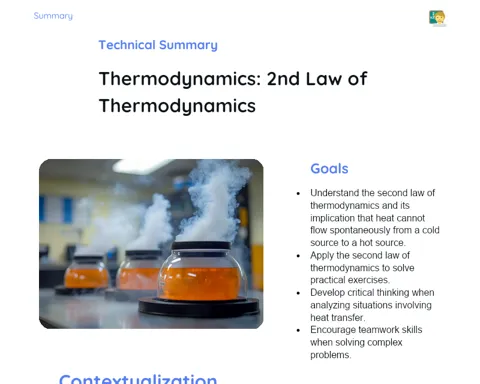Linear Expansion | Active Summary
Objectives
1. 🎯 Understand the concept of linear expansion and how it applies in the real world.
2. 🎯 Develop skills to solve practical and theoretical problems involving the expansion of bodies, especially iron bars.
Contextualization
Have you ever stopped to think about why bridges and train tracks have small gaps between parts? This is to allow for linear expansion! Hot climates cause these materials to expand, and the extra space prevents them from breaking. This property is essential for building safe and durable structures, and understanding how it works helps us avoid accidents and better plan our cities and infrastructures.
Important Topics
Linear Expansion Formula
The linear expansion of an object can be calculated using the formula: ΔL = L₀ * α * ΔT, where ΔL is the change in length, L₀ is the initial length, α is the linear expansion coefficient of the material and ΔT is the temperature change. This coefficient varies for different materials and is essential for designing structures that need to handle temperature changes.
-
The linear expansion coefficient, α, is a characteristic physical property of each material, indicating how much the length of a material changes per unit of initial length per degree Celsius of temperature change.
-
The formula shows that the change in length is directly proportional to the initial length, the linear expansion coefficient and the temperature change, meaning that the larger the initial length, the greater the expansion for the same temperature change.
-
Understanding and applying this formula is fundamental for engineers and architects, as it allows the precise calculation of the expansions and contractions structural elements may experience under different environmental conditions.
Practical Applications of Linear Expansion
Linear expansion is not just a theoretical concept but a fundamental physical property with numerous practical applications. For example, in structures such as bridges and railways, it is crucial to consider expansion to avoid structural failures. It is also used in technologies such as mercury thermometers, where the expansion of the liquid indicates temperature variations.
-
In civil engineering, linear expansion is applied in the design of bridges, roads, and buildings, allowing them to expand and contract without damage under different weather conditions.
-
In industrial applications, such as the manufacturing of train tracks, controlling linear expansion is vital for ensuring the safety and efficient operation of transportation systems.
-
In thermometry, the expansion of liquids or solids within a capillary tube is used to measure and indicate temperature changes, based on the property of material expansion.
Linear Expansion Experiments
Conducting practical experiments helps students visualize and better understand the concept of linear expansion. Experiments such as heating metal bars and observing their changes in length allow for a deeper understanding of the phenomenon.
-
Simple experiments, such as heating a metal bar and measuring its expansion, can be performed with low-cost materials and are effective in demonstrating linear expansion in practice.
-
These experiments not only reinforce the theoretical formula but also help students see physics in action, connecting theory with the real world.
-
Observing the variations in expansion in different materials provides insights into how material properties affect expansion, and why it is essential to consider these factors in engineering and design applications.
Key Terms
-
Linear Expansion: Increase in the length of an object due to an increase in temperature. This phenomenon is observed in many materials, especially solids.
-
Linear Expansion Coefficient (α): A measure of the change in length of a solid for each degree Celsius change in temperature. It is a characteristic physical property of each material.
-
Mercury Thermometer: A device that measures temperature using the expansion and contraction of mercury within a capillary tube. This is a practical example of linear expansion applied in technology.
To Reflect
-
How can the variation in the linear expansion coefficient between different materials affect the design of structures that need to handle large temperature variations?
-
Why is it important to consider linear expansion when designing technologies such as train tracks and bridges, and how can this affect the safety and efficiency of these structures?
-
In what way can understanding linear expansion help solve practical problems in your daily life or in future professional careers in engineering or architecture?
Important Conclusions
-
We reviewed the concept of linear expansion and how it applies in various practical contexts, from the construction of bridges to the operation of thermometers.
-
We understood the importance of the linear expansion coefficient, which varies for each material and directly affects the design and safety of structures and devices.
-
We conducted practical experiments that allowed us to visualize and measure linear expansion, connecting theory with real applications.
To Exercise Knowledge
- Choose a metallic object in your house and try to measure its expansion on different days with varying temperatures. Record your observations. 2. Research and create a short report on how linear expansion is used in the aerospace industry. 3. Design a bridge made of popsicle sticks that can expand and contract without breaking, simulating linear expansion.
Challenge
Create a simple device that can measure the linear expansion of your window over the course of a week. Document your findings and present them in a video or presentation to the class.
Study Tips
-
Regularly review the linear expansion formula and make small study cards to help with memorization.
-
Watch online videos of linear expansion experiments to see how other scientists and students perform these experiments.
-
Discuss with your peers or family about practical examples of linear expansion that they encounter in everyday life, such as in kitchens or in mechanics.



